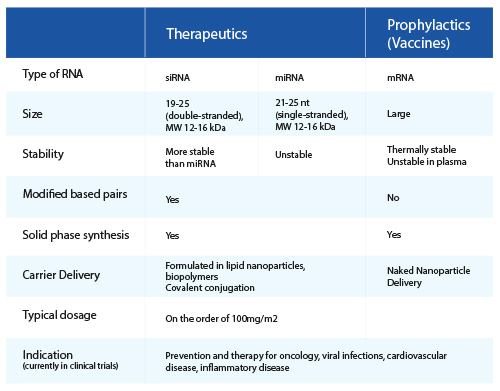By Elina Gousseinov, Mikhail Kozlov, Claire Scanlan, Aaron Hammons, Ling Bei, Youssef Benchek, Karim Pirani, Priyabrata Pattnaik, and Ruta Waghmare
RNA-based biopharmaceuticals, which includes therapeutics and vaccines, is a relatively new class of treatment and prophylactic for a number of chronic and rare diseases, including cancer, diabetes, tuberculosis, and certain cardiovascular conditions (Table 1). The field holds great promise in the prevention and treatment of these diseases as demonstrated by early-phase clinical trials as well as significant investment by the drug development community. According to market research, DNA and RNA therapeutics are growing at 12% CAGR and expected to reach $1.2 billion by 2020.

Of the 700 DNA and RNA therapeutics that are in the drug development pipeline, the majority of these—about 430—are still in the early (preclinical) stages of development, and nearly 35% are targeting oncology. Globally, there are approximately 160 companies and 65 universities that are developing RNA-based therapies. There are 12 mRNA vaccines currently in development, seven of which are being developed by Curevac. Based on current market trends, the RNA therapeutics market appears more promising than DNA therapeutics.
At nearly 35%, the oncology segment is emerging as the leading target indication, and RNA interference (RNAi) and RNA antisense technologies appear to be dominating the market. RNAi is a gene silencing technology in which RNA molecules inhibit gene expression by targeting and destroying specific mRNA molecules. RNA antisense technology involves synthesizing an RNA strand that binds to a specific mRNA or to a splicing site on a pre-mRNA molecule to prevent translation. The major challenges associated with the commercialization of these RNA-based therapies are toxicity and drug delivery. The features of an ideal drug delivery solution include biocompatibility, protection from nucleases, controlled distribution (both persistence and location), full activity, and safety.
RNA-Based Therapeutics
RNAi works by silencing or turning off gene expression. RNAi was first discovered in plants in the early 1990s, and termed “post-transcriptional gene silencing.” In 2001, it was shown that this process also occurs in mammalian cells using similar mechanisms. There are two types of RNA that are central to RNAi technology: small interfering RNA and micro RNA.
Small interfering RNA (siRNA), also referred to as short interfering RNA or silencing RNA, triggers mRNA degradation. Only a few molecules of siRNA per cell are required for effective gene silencing. siRNA is formed when the dicer enzyme cleaves the dsRNA after it enters the cell. These RNAs are most commonly delivered into cells using microinjection or a transfection agent. Many companies now offer siRNA-delivering reagents to simplify this process.
Micro RNA (miRNA) is a specific class of noncoding RNAs that are 19-25 nucleotides in length. miRNA inhibits translation by acting as a guide strand for the RNA-induced silencing complex (RISC) to its mRNA target. While siRNA silencing requires an exact match to its target mRNA, miRNA can function through imperfect base-pairing.
RNA-Based Vaccines
The direct vaccination with mRNA molecules that encode a target antigen induces an immune response after uptake by antigen-presenting cells. Typically, mRNA vaccines are synthetically produced by an enzymatic process, and offer the advantage of tight control over the immunogenic profile, pharmacokinetics, and dosing. mRNA can be easily optimized for improved codon usage, stability, and antigenic properties.
Clinical trials indicate that mRNA delivered naked, in liposomes, coated on particles or transfected in dendritic cells in vitro can result in demonstrable protective immune response. mRNA can also be tailored to act as an adjuvant to stimulate the innate immune system. RNA-based vaccines can be developed, manufactured, and administered at point-of-care in a matter of weeks, potentially addressing future pandemic threats. Low dosages equate to mobile manufacturing suites at costs well below existing vaccine processes.
Manufacturing RNA-Based Biopharmaceuticals
Special care needs to be taken in the production of RNA-based biopharmaceuticals because these agents are very sensitive to degradation due to chemical instability and/or the ubiquitous presence of endonucleases (particularly in the laboratory setting). The general schematic for the production of RNA-based biopharmaceuticals is shown in Figure 1.

siRNAs were first produced using chemical synthesis, but now they can be produced in any laboratory using in vitro transcription methods. mRNA purification (post-chemical synthesis) typically includes concentration, precipitation, extraction, and chromatographic steps. A 5 kD membrane cut-off is generally used for concentration and diafiltration in mRNA processes. Because siRNA is smaller than mRNA, a 1 kD membrane cut-off is used for adequate retention of the siRNA product. Traditional ion exchange (IEX) media, especially anion exchange (AEX), remains the most popular technique that is used in both pure RNA and RNA packaged for delivery.
The largest roadblock for the success of RNA-based therapeutics is their delivery to the diseased cell. Conjugation of the RNA therapeutic is increasingly being used as a strategy to improve its delivery and uptake. The dominant and most-studied strategy is the use of lipid-based delivery systems. Another promising lipid delivery technology is the proprietary Smarticles® delivery platform developed by Novosom and now owned by Marina Biotech.
Conclusion
RNA-based biopharmaceuticals are a relatively new class of therapies that are demonstrating significant growth and potential for the treatment and prevention of chronic and rare diseases. Special care needs to be taken in the production of these therapies and vaccines because RNA is very sensitive to degradation. The major challenges associated with the commercialization of these RNA-based therapies include toxicity and drug delivery. However, new technologies are emerging to overcome some of these challenges.
Elina Gousseinov, Mikhail Kozlov, Claire Scanlan, Aaron Hammons, Ling Bei, Youssef Benchek, Karim Pirani, Priyabrata Pattnaik, and Ruta Waghmare ([email protected]) work at EMD Millipore.


